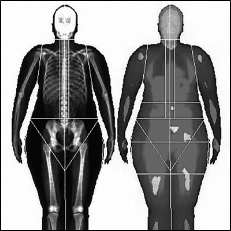Changes in Bone Mineral Density and Body Composition in Obese Patients Undergoing Bariatric Surgery
DOI:
https://doi.org/10.53903/01212095.96Keywords:
Body composition, Densitometry, Bariatric surgery, Obesity, SarcopeniaAbstract
Obesity is a public health problem that significantly affects the world population, increasing morbidity and mortality rates. Although there are multiple treatments for obesity, the most effective treatment in the long term is surgical. Bariatric surgeries, such as Y-de-Roux gastric bypass and gastric sleeve, have not only reduced body mass at the expense of reducing fat mass, but have also reduced the prevalence of comorbidities such as type 2 diabetes mellitus, dyslipidemia, arterial hypertension, among others. However, bariatric surgeries have also been shown to have negative effects on the musculoskeletal index and bone mineral density, variables that must be taken into account during pre-surgical assessment and post-surgical recommendations. From the results of the study, it can be inferred that bariatric surgery causes osteopenia / osteoporosis and sarcopenia in the long term based on the statistically significant decrease in bone mineral content (BMC) and fat-free lean tissue in the short term, which is why a long-term follow-up (longer than 12 months) of these patients is proposed.
Downloads
References
World Health Organization. Fact Sheet N311: Obesity and Overweight [internet]. 2018[citado 2019 jun. 1]. Disponible en: https://www.who.int/news-room/fact-sheets/detail/obesity-and-overweight.
De Lorenzo A, Soldati L, Sarlo F, Calvani M, Di Lorenzo N, Di Renzo L. New obesityclassification criteria as a tool for bariatric surgery indication. World J Gastroenterol.2016;22(2):681-703.
Hallgreen CE, Hall KD. Allometric relationship between changes of visceral fat andtotal fat mass. Int J Obes (Lond). 2008;32(5):845-52.
Pories WJ, Dohm LG, Mansfield CJ. Beyond the BMI: the search for better guidelinesfor bariatric surgery. Obesity (Silver Spring). 2010;18(5):865-71.
Lutz TA, Bueter M. The physiology underlying Roux-en-Y gastric bypass: a statusreport. Am J Physiol Regul Integr Comp Physiol. 2014;307(11):R1275-91.
Boutin RD, Yao L, Canter RJ, Lenchik L. Sarcopenia: Current Concepts and ImagingImplications. AJR Am J Roentgenol. 2015;205(3):W255-W66.
García-Caballero M, Reyes-Ortiz A, García M, Martínez-Moreno JM, Toval-Mata JA.Super obese behave different from simple and morbid obese patients in the changesof body composition after tailored one anastomosis gastric bypass (BAGUA). NutrHosp. 2014;29(5):1013-9.
Adams TD, Davidson LE, Litwin SE, Kim J, Kolotkin RL, Nanjee MN, et al.Weight and metabolic outcomes 12 years after gastric bypass. N Engl J Med.2017;377(12):1143-55.
Valezi AC, Marson AC, Merguizo RA, Costa FL. Roux-en-Y gastric bypass: limblength and weight loss. Arq Bras Cir Dig. 2014;27 Suppl 1:56-8.
Thivel D, Brakonieki K, Duche P, Morio B, Boirie Y, Laferrere B. Surgical weightloss: impact on energy expenditure. Obes Surg. 2013;23(2):255-66.
Tamboli RA, Hossain HA, Marks PA, Eckhauser AW, Rathmacher JA, Phillips SE,et al. Body composition and energy metabolism following Roux-en-Y gastric bypasssurgery. Obesity (Silver Spring). 2010;18(9):1718-24.
Schafer AL, Li X, Schwartz AV, Tufts LS, Wheeler AL, Grunfeld C, et al. Changes invertebral bone marrow fat and bone mass after gastric bypass surgery: A pilot study.Bone. 2015;74:140-5.
Carrasco F, Ruz M, Rojas P, Csendes A, Rebolledo A, Codoceo J, et al. Changes inbone mineral density, body composition and adiponectin levels in morbidly obesepatients after bariatric surgery. Obes Surg. 2009;19(1):41-6.
Johnson JM, Maher JW, DeMaria EJ, Downs RW, Wolfe LG, Kellum JM. The longtermeffects of gastric bypass on vitamin D metabolism. Ann Surg. 2006;243(5):701-4;discussion 4-5.
Ciangura C, Bouillot JL, Lloret-Linares C, Poitou C, Veyrie N, Basdevant A, et al.Dynamics of change in total and regional body composition after gastric bypass inobese patients. Obesity (Silver Spring). 2010;18(4):760-5.
Bazzocchi A, Diano D. Dual-energy x-ray absorptiometry in obesity. CMAJ.2014;186(1):48.
Levitt DG, Beckman LM, Mager JR, Valentine B, Sibley SD, Beckman TR, et al.Comparison of DXA and water measurements of body fat following gastric bypasssurgery and a physiological model of body water, fat, and muscle composition. J ApplPhysiol (1985). 2010;109(3):786-95.
Silver HJ, Welch EB, Avison MJ, Niswender KD. Imaging body composition inobesity and weight loss: challenges and opportunities. Diabetes Metab Syndr Obes.2010;3:337-47.
Maghrabi AH, Wolski K, Abood B, Licata A, Pothier C, Bhatt DL, et al. Two-yearoutcomes on bone density and fracture incidence in patients with T2DM randomizedto bariatric.

Downloads
Published
How to Cite
Issue
Section
License

This work is licensed under a Creative Commons Attribution-NonCommercial-ShareAlike 4.0 International License.
La Revista Colombiana de Radiología es de acceso abierto y todos sus artículos se encuentran libre y completamente disponibles en línea para todo público sin costo alguno.
Los derechos patrimoniales de autor de los textos y de las imágenes del artículo como han sido transferidos pertenecen a la Asociación Colombiana de Radiología (ACR). Por tanto para su reproducción es necesario solicitar permisos y se debe hacer referencia al artículo de la Revista Colombiana de Radiología en las presentaciones o artículos nuevos donde se incluyan.







